Sky-Watcher EQ8-R Pro (First Impressions)
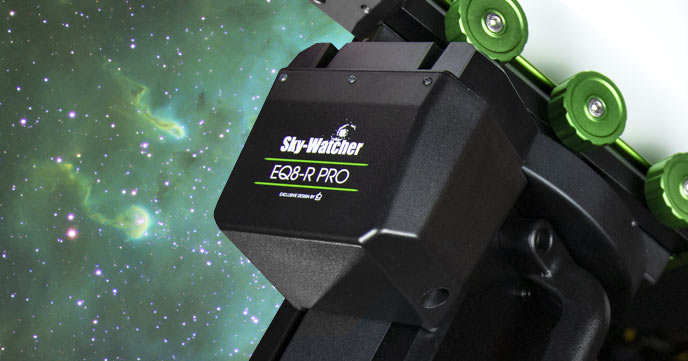
A few weeks ago, I was lucky enough to receive a very large package in the mail, the Sky-Watcher EQ8-R Pro. Some people get excited about the arrival of flowers or perhaps a new book from Amazon at their door.
Me? I prefer over 100 pounds of deep-sky astrophotography equipment.
The brand new EQ8-R Pro is an observatory-class equatorial telescope mount capable of handing advanced astrophotography equipment, and one of the heaviest objects I have ever attempted to lift on my own. I’d like to think that deadlifting the heaviest of astronomy equipment is something I’ll always be able to do, but that is sadly not true.
My image of the Whirlpool Galaxy captured using the EQ8-R Pro mount.
I believe that most folks interested in an equatorial mount with this level of competence will be installing it in a permanent backyard observatory. As many of you know, I continue to haul all of my astrophotography in and out of the garage each and every time I set up.
Before I share any more down-to-earth amateur astrophotographer problems with you, I feel that it is important to let you know exactly how and why an unreleased Sky-Watcher EQ8-R Pro computerized GoTo mount was delivered to me.
Why I Do I Have One?
The team at Sky-Watcher wanted someone to review the EQ8-R Pro mount in a “real world” situation, and my light-polluted backyard in the city fit the bill quite nicely. To be quite honest, I did not have a need for a computerized GoTo telescope mount this large, but I am always happy to try out new equipment to better understand this hobby overall.
I have developed a great relationship with Sky-Watcher USA over the past year, and feel very comfortable demoing new products on my YouTube channel and website. This would not be the case if there were strict guidelines about what I can, or can’t say about the equipment, and I am happy to report, that there aren’t!
Despite what others have said in the forums, I have not “sold out” (a recent Cloudy Nights forum thread attacked my integrity), and earning my income by convincing someone to purchase a product or service I don’t believe in is exactly the type of scenario I removed from my life the moment I took on AstroBackyard full-time.
Sorry for the mini-rant, but I felt that this was important to mention moving forward. There’s bound to be skeptics in all disciplines, but the cost and potential frustrations involved with astrophotography gear can either bring out the best, or worst of us.
To make things even more interesting, I’ve mounted a Sky-Watcher Esprit 150 Apochromatic Refractor and Starlight Xpress monochrome camera to the EQ8-R Pro. Sky-Watcher offers this imaging configuration as a package, and I believe you could call this one a “backyard astrophotographers dream”. I think now is a great time to remind you that my time with this setup is limited.
As with all of the equipment I review on AstroBackyard and on YouTube, I was not paid to endorse this product, and it will be returned to the company after my review. While this “dream setup” is available to me, you can bet your biscuit I am going to spend every second of clear sky collecting photons with it.
The Sky-Watcher EQ8-R EQ can handle 110-pounds of equipment.
The Sky-Watcher EQ8-R Pro
The Sky-Watcher EQ8-R Pro (and Rh versions) officially launched on October 18th, 2019, almost exactly a year after I received my EQ6-R Pro (this mounts younger sibling). This robust equatorial telescope mount boasts an impressive 50 Kg (110-pound) maximum payload capacity, a belt-drive system on both axes, an integrated cable management system, and more. Despite these useful traits and advanced features, I like to think of the EQ8-R Pro as a big, black EQ6-R Pro, and that’s a good thing.
After nearly a year of use and countless astrophotography images later, I reviewed the Sky-Watcher EQ6-R Pro. I had a wonderful experience with this mount, and judging from the comments I received on this blog and social media, others did too.
I am a big fan of the Sky-Watcher SynScan system, as I regularly still use and enjoy the hand controller on my astrophotography mounts. I’ve used the Celestron NexStar and iOptron Go2Nova hand controllers in the past, but I am most comfortable with Sky-Watcher mounts thanks to over 5 years of experience using them (starting with the Sky-Watcher HEQ5 in 2014).
The Auto Slew Home command appears when you turn the EQ8-R Pro on.
First Impressions
It was refreshingly simple and straightforward to get the EQ8-R Pro aligned and tracking my desired astrophotography subjects. With a careful polar alignment using the QHY PoleMaster, a 1-star alignment was all I needed to center my target using a telescope with a 1000mm+ focal length. Astonishingly, I’ve actually kept and stacked every single exposure taken on the EQ8-R Pro mount since it’s been in the backyard.
I used Astro Photography Tool to automate my imaging sequence with the Starlight Xpress SX42 camera and utilized the autoguiding port on the EQ8-R Pro for accurate 5-minute exposures. The Starlight Xpress filter wheel contained 6nm Astronomik narrowband filters, Ha, OIII, and SII. I am certainly not used to capturing images at a focal length of 1000mm, so I couldn’t help but get a closer look at some of the nebulae I’ve had a hard time reaching with my wide-field setups.
Here is an image of the Bubble Nebula captured using the Esprit 150 refractor of the EQ8-R Pro:
The mount slews and tracks very quietly. In fact, the EQ8R-Pro is as quiet (if not quieter) as the EQ6-R Pro. Compare this to the notoriously loud Celestron CGX-L. This is certainly not a primary reason to invest in a mount, but you’d be surprised at how much this aspect matters to you when switching targets at 2 am on a weeknight.
PHD2 Guiding Graph
The judge of an astrophotography mounts tracking performance is often in the PHD2 guiding graph. I feel that it is very important to mention that the total RMS error should not be viewed as the be-all-end-all judge of the mounts tracking abilities. There are many variables that come into play here, including the settings you are using in PHD2, seeing conditions, and a lot more.
With that being said, here is a recent look at the graph I was seeing with the Sky-Watcher EQ8-R Pro during a night of imaging. This was using the On-Camera guiding setting on the Lodestar X2. I would expect pulse guiding through a direct connection between the mount and PC to be even better.
Practicality
The mount is extremely heavy, the EQ mount head itself (56 pounds), and especially the matching pier tripod (64 pounds). It is impossible to safely lift the tripod and equatorial mount together as a single unit. Seriously, don’t even try.
This weight makes for a rather lengthy setup routine if you are carrying the EQ8-R Pro to and from the house or garage to your yard. The tripod is not only heavy but awkward to manage over large areas. If you have a bad back, investing in a permanent setup or buggy-style transportation device is your only option.
The built-in heavy-duty handles on the mount make transporting the mount head to the tripod much easier, and they actually make carrying the EQ8-R a bit easier than some of the lighter, yet more awkward mounts. In contrast, the CGX-L has a single handle, that puts your one-arm strength to the test.
The built-in power, auxiliary, and USB 3.0 ports are extremely useful when running advanced astrophotography setups that include multiple cables running down the mount. Setups that include a cooled astronomy camera, motorized focuser, filter wheel, and guide camera will appreciate this feature the most.
Integrated Cable Management System.
Polar Alignment
One major difference between this mount and the smaller EQ6-R is the lack of a built-in polar scope. To polar align the Sky-Watcher EQ8-R Pro you must mount the optional polar scope and l-bracket, or use an electronic polarscope as I did.
I mounted the QHY PoleMaster to the front of the telescope dovetail. This is how I polar aligned the Celestron CGX-L and 8″ RASA, so thankfully I already had the ADM PoleMaster adapter handy.
For this method to work, you’ll want to make sure that the telescope is in the home position on both axes. On the Sky-Watcher EQ8-R Pro, it simply means using the homing sensors to find this position when you turn the mount on. After setting the home position on the hand controller, the mount will run through a series of small movements to identify true “home”.
The QHY PoleMaster is a great solution for polar aligning the EQ8-R Pro.
Adjusting the EQ8-R Pro to your latitude is done via the heavy-duty crossbar style bolt (I’d love to know the technical description for this style of bolt in the comments), which is smooth and solid. The big green knobs on either side of the mount head base allow for precise azimuth control. Everything feels extremely solid and secure, which is exactly what you would expect on a telescope mount of this caliber.
Tracking Accuracy
An astrophotography setup that includes a 32-pound apochromatic refractor telescope at 1040mm focal length demands a robust tracking platform. With two 26-pound counterweights attached to the other end, balancing this precious cargo was rather easy. More importantly, the load was secure thanks to the 3 massive locking bolts on the dovetail saddle.
The RA and DEC axes feature a unique design I have not seen before. Each axis rotates on a massive, silver disc stating “Warning, Do Not Apply Pressure” (shown below). The Sky-Watcher EQ8-R Pro features a belt drive system in each axis to minimize backlash and reduce periodic error. The onboard computer includes a PPEC training program for those that want to maximize the precision of the mount in a permanent setting.
The massive silver disc design of the RA and DEC axes.
My primary imaging camera with this setup is a Starlight Xpress SX-42 and a 7-position filter wheel. This is a monochrome CCD camera with impressive specs. An OAG (Off-axis guider) and Starlight Xpress Lodestar X2 monochrome camera handle the autoguiding for this rig, and in my first few runs with this configuration, ran exceptionally well.
I used the popular PHD2 Guiding software to autoguide with the Esprit 150 on the EQ8-R Pro. Because the Lodestar X2 camera was fitted to the OAG on the filter wheel, I was guiding on a star using a focal length of 1040mm!
For each of the deep-sky objects I chose to photograph, I collected 5-minute exposures using 1.25 Astronomik 6nm filters. The tracking accuracy of the Sky-Watcher EQ8-R Pro was exceptional, with pin-point, round stars in each and every 5-minute exposure. Utilizing the autoguide port on the EQ8-R Pro, I see no problem shooting 10 or even 20-minute exposures with this setup.
Mount Specifications
- Mount Type: High-capacity motorized equatorial
- Tripod: Optional heavy-duty pier tripod
- Power Requirements: DC11-16V, 3 amp
- Motor Drive: 0.9° hybrid stepper motor
- Tracking Modes: Equatorial Only
- Alignment Procedures: 1, 2, 3 star-alignment
- Hand controller: SynScan, PC Direct
- Database: Messier, NGC, IC and SAO Catalogs (42,900 total)
- Cable Management: 4 x USB 3.0, 3 x 2.1mm Power Ports, 3 X Serial Connections
- Dovetail Compatibility: D-Style
- Latitude Range: 10° – 65°
- Mount Weight: 56.8 pounds
- Tripod Weight: 64.8 pounds
- Payload Capacity: 110 pounds
Final Thoughts
4 nights with the Sky-Watcher EQ8-R Pro is not enough mileage to write a meaningful review. I will continue to spend time with the mount over the next few months, and see how well it handles the cold Canadian winter. In the brief (clear) windows of opportunity I had, I managed to collect some impressive images using the monochrome CCD camera and filter wheel on this mount.
Here is an image of IC 410 (The Tadpoles Nebula) captured in the Hubble palette (SII=RED, Ha=GREEN, OIII=BLUE). I captured roughly 1.5 hours worth of exposure time through each Astronomik 6nm filter and mapped the monochrome images to color channels in Adobe Photoshop.
The Tadpoles Nebula. Esprit 150 on the EQ8-R Pro Mount.
I understand that the leap in progress (as far as image quality) is primarily due to upgrading to a monochrome CCD camera from a one-shot-color CMOS rather than the mount itself. However, this was a very demanding optical system that requires reliable tracking and operation.
Overall, I was extremely impressed with the simple and reliable performance of the Sky-Watcher EQ8-R Pro. It made the transition from a medium-sized mount to an “observatory-class” monster a smooth transition. Personally, I have a soft spot for Sky-Watcher mounts based on my own history with the brand.
For those looking to upgrade their iOptron, or Celestron mount to something with a greater payload capacity, you may prefer to stick to what you’re used to. Based on my early successes with this mount, and my preference to the SynScan system, I think that the Sky-Watcher EQ8-R is a top contender in this category.
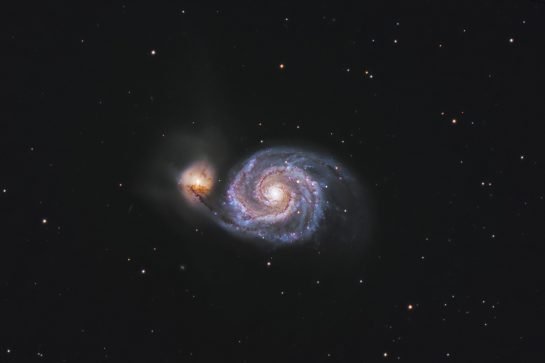

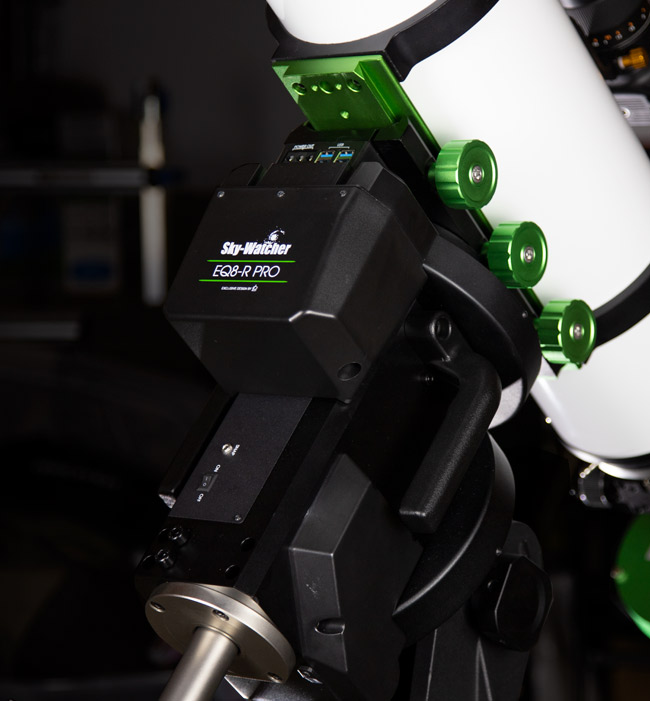



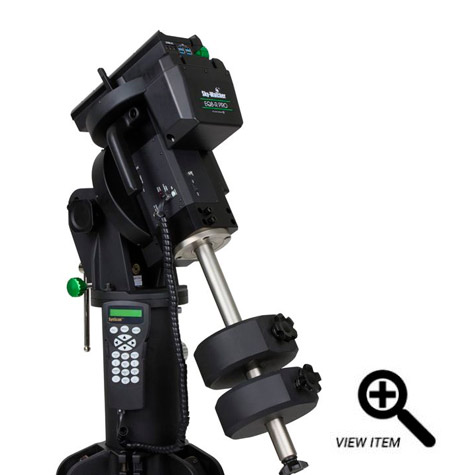

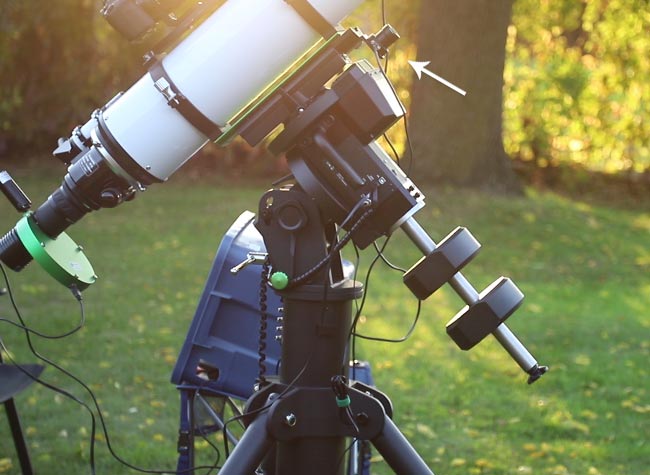
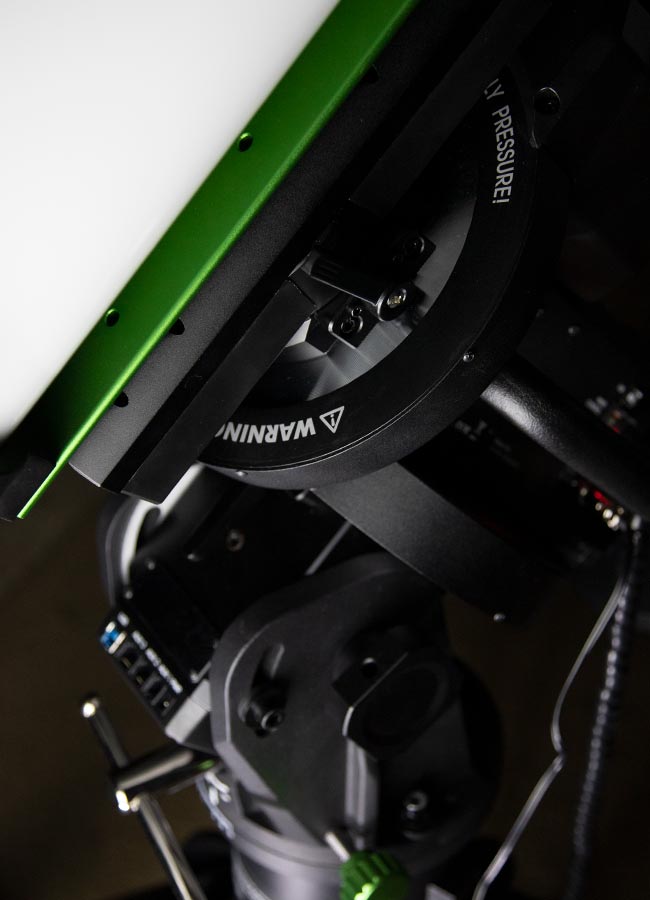
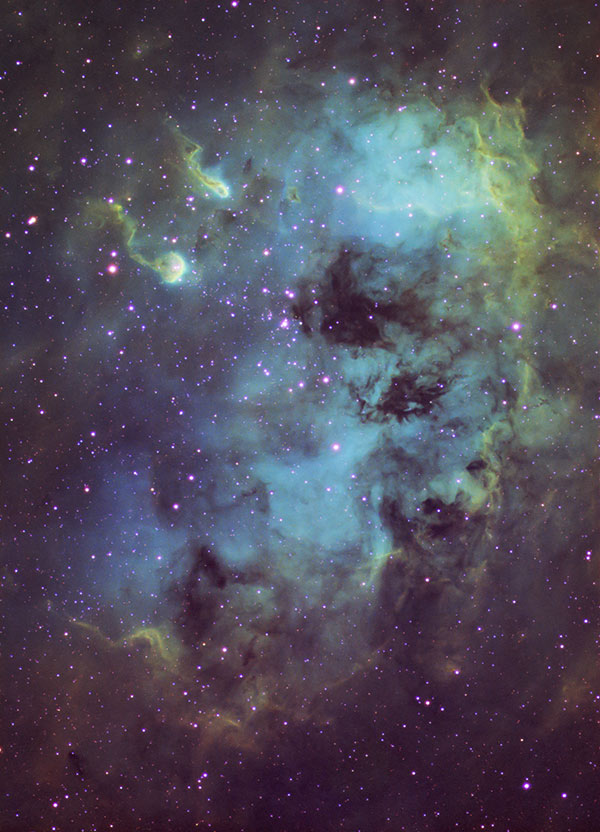
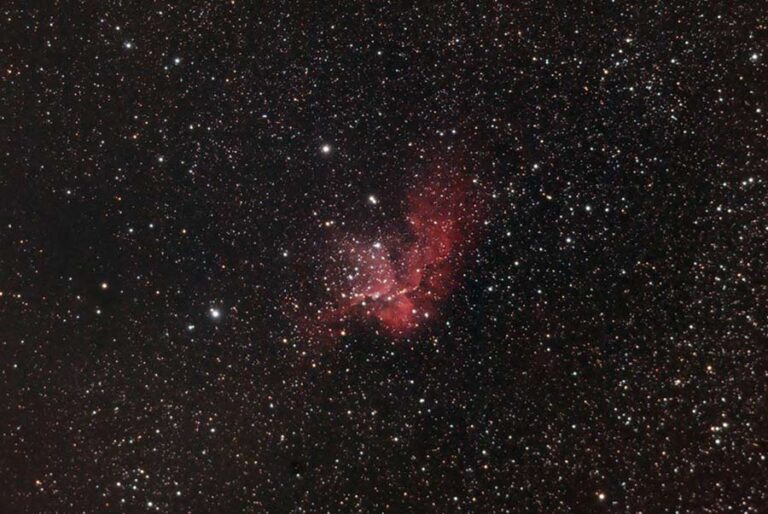
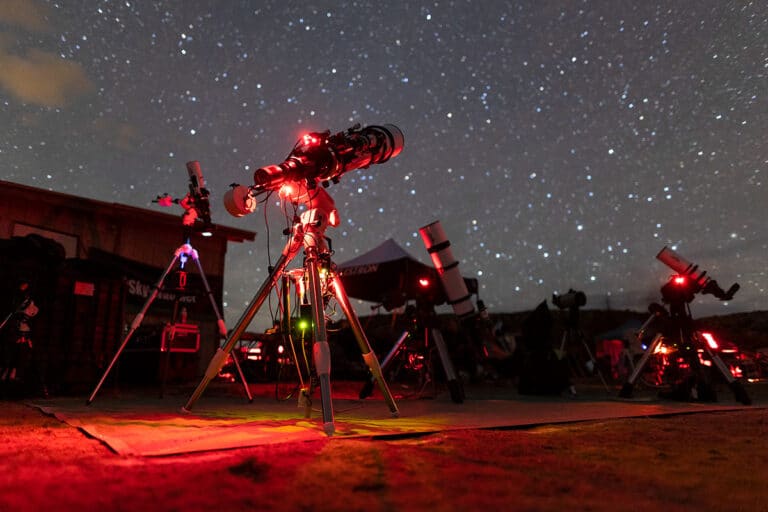
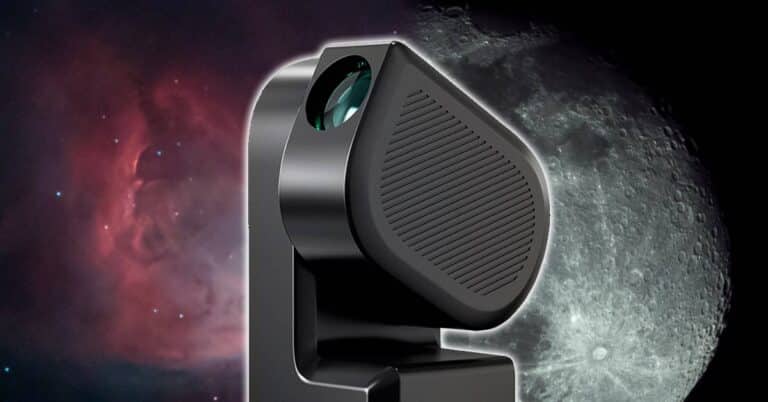
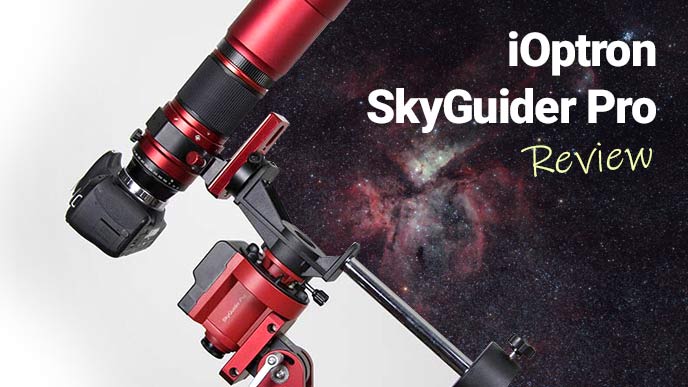
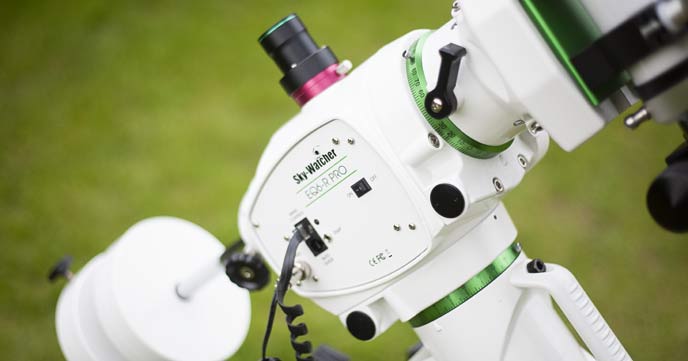

Trevor- as always great video and honest review. Myself only recently (total of 4 sessions) started with a Star Adventurer Pro tracker with a Canon 7D and variety of lens. A mount and rig like this is a far ways off. What really caught my attention though is your use of the monochrome camera and filter wheel. As I still use a DSLR, would be interested in a comprehensive video and/or course on the use of a filter wheel. I do also have a ZWO ASI120MM monochrome camera I now use for tracking and have a better camera on my short list. Keep providing the great content!! Side note- you need to add a knit hat or ball cap to your merchandising stuff :).
Hi Joe, thank you very much for the kind words! As for the filter wheel, yes, I will cover that topic, along with the necessary filters, OAG and everything else very soon! It was an eye-opening experience to shoot with a true monochrome CCD 🙂 I’ve been working with some designers to create some more interesting merch designs, I will be sure to include a hat and/or toque! 🙂
Makes my Star Adventurer look like a hood ornament. As always I enjoyed your review which never fails to inspire me to take the next baby step. Currently grappling with improving my post processing skills. I even developed a cheat sheet extracted from your video tutorial. Thanks for being so generous in sharing your hard earned experience.
Trevor,
Based on the videos I’ve seen and blogs I’ve read, I believe you are a man of integrity and feel your reviews are your own honest opinions. I find them valuable and hope that the ramblings of some do not prevent you from continuing. Your efforts are much appreciated, and through you, I have learned a lot about this hobby.
Thanks for taking the time to do all this.
Dave
I really appreciate that, Dave. Thank you!
You’re a lucky man Trevor.. Regarding your review, I wondered if you could publish RMS error in both RA and DEC. Also, do you know if the USB ports are powered? In the iOptron CEM60, they are not which make them not reliable.
Great review Trevor. I would love to have the EQ8-R but, as you mentioned, it really needs a permanent setup and unfortunately that is just not a possibility for me at the moment. Regarding the sellout comments on the cloudy nights forum:don’t let it get you down. There are plenty of us who trust your judgement and integrity and will continue to do so. Astrobackyard has been my goto channel on YouTube for a long time and it’s been great to watch the channel grow and to follow you on your astrophotography journey. Onwards and upwards Trevor!! We’ll be right there with you. 🙂
Hi Trevor,
It always amazes me why people feel the need to blame and shame others based on nothing else then suggestion, while hidden behind a username. Ignoring I guess is the best you can do.
Anyway, thanks again for this review, as always with all your blog post, a fun to read/view.
Thanks to your posts and photos I dared to start this hobby last year on my appartment balcony in a Bortle 9 environment using an EQ6 and ES 102 APO. And it didn’t disappoint me at all!!
So thanks again mate, keep on posting good stuff and give your dog a big hug.
Kind regards,
Theo
Nice initial impressions. The EQ8-R reminds me of my old Takahashi NJP mount (25kg) which is a pain to drag along especially as there are no handles to help with lifting and gripping.
As for the EQ8-R tripod/pier, I would suggest to go for the iOptron 360 pier instead and have some holes drilled into the top plate (or look for adapters). This should cut off some weight as well.
Good review Trevor, this type of mount is incredible, it is beautiful and it seems incredible that it is quieter than the EQ6-R, I wanted to ask you what is the difference between the Version EQ8-R and the EQ8-RH?
The only difference between EQ8-R and EW8-Rh that I am aware of are high-resolution Renishaw encoders installed on the R.A. axis for the “Rh” version.
That comes along with a steep increase in price, e.g. 5500 GBP for the Rh version and 3000 GBP for the one without encoders if you look at prices in Europe. I guess it is a similar difference for the U.S…
Thanks Tevor for providing very useful info for those of us new to AP. Keep it coming.
Thanks Trevor!
I’ve been trying to decide between the iOptron CEM 120 and the EQ-8-RH for my POD MAX. Your review helps! We intregrate mostly Bisque ME-II’s with MAXs, but I don’t need a 240 lb capacity, yet. 😉
Great shots!
CS!
Wayne
Which is the better mount this mount or the CGX-L you have both what about software alignment on the EQ8-R
Hi Trevor,
Have you had anymore time using the mount since the initial review? Any more thoughts on it?
Thanks,
Greg
How do you like the Sky-Watcher EQ 8 in cold weather? Is the cold temperature causing issues to the drive belt? I am presently looking at an EQ mount and debating between the EQ 8 and the Asto-Physics 1000.
I am waiting for the Canadian dollar to go up in value against the US.
I live in Northern Ontario and plan on getting a SkyShed Pod so I don’t have to set-up and take down every time. Nice work.
Thank You!
Great review Trevor, I’m wrestling with purchasing a Skywatcher EQ8-R, I do have a bad back, Lol. But my alternative is the Celestron CGX-L. Do you have any opinions in difference or anyone else?
HI Trevor;
Do you have a follow up from the winter and how its holding up over the few months?
Hi Michael. I have had zero issues with this mount, whatsoever. For comparison, the Celestron CGX-L has thrown me a few curveballs. The tracking accuracy has been very impressive (with guiding) considering the focal length I’ve been shooting at with this mount.
Just stumbled on this mount and wow its pretty heavy for the load factor. After trying out several mounts to support a C14, I ended up going with an AP1100 without Encoders and have no issues getting good data. I also have a AP1600 with encoders so that is why I will add that I still autoguide(AOX/OAG) some with both systems. While its nice to have these Renishaw encoders, you can save some big money for quality filters, autoguider, and camera upgrades. My MX+ does have a home switch which allows for a quick method to getting the positioning back in order(currently doesn’t have the option for encoders yet anyway) but I have had less problems with my mounts without the encoders verses the one that does have the Renishaw encoders. Just my two cents because both the MX+ and AP1100 without encoders are 8k but both are my favorite portable mounts.
hmmmm …. only because of You guys ( Trevor and Dylan ) i decided to buy EQ8 R Pro with RASA 11:)
Thank you for a nice and honest fb about the products. Well just ordered … now i need to deal with the clouds 😞
For us portable users who need something with more capacity than an EQ6, but less back-crushing than an EQ8, it would be great if Sky-Watcher would release something in between. Specifically, I would love a S-W mount with 32 kg (70 lb) of capacity that weighed around 45 lbs. This would be the ideal Goldilocks size for many astronomers. It’s odd they don’t make such a thing, because they have a huge gap in their product line.